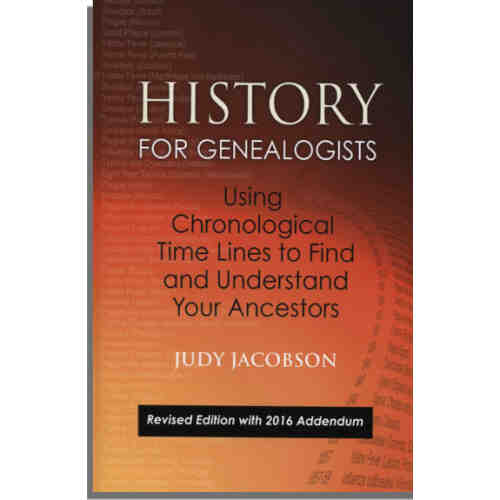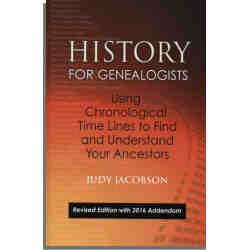History for Genealogists is a rarity: It’s one of the very few history books in print that is written for genealogists. Here’s what we mean: Let’s say you have lost track of your 1880 ancestor in Iowa. Have you considered that he might have moved there during the Economic Panic of 1873? Or maybe your forebears were living in Texas in the 1840s. Did you know that they might have come from Kentucky as part of the “Peters Colony”? Are you aware that you can learn a great deal about your ancestors if they belonged to a labor or fraternal organization like the Amalgamated Clothing Workers, Brotherhood of Locomotive Engineers, or the Catholic Family Life Insurance Society? In other words, knowing a little history can go a long way in helping you find elusive ancestors.
As author Judy Jacobson puts it, “Genealogy lays the foundation to understand a person or family using tangible evidence. Yet history also lays the foundation to understand why individuals and societies behave the way they do. It provides the building materials needed to understand the human condition and provide an identity, be it for an individual or a group or an institution.”
History for Genealogists answers fundamental questions about our forebears. For example, if you are trying to learn when your ancestors left one place for another, it would be helpful to ask the question, “Why did they leave?” Did it have to do with a military conflict, social injustice, religion, disease, economic hardship, a natural disaster? No matter what the explanation, Mrs. Jacobson has a historical time line that could lead to the explanation. For example, your ancestor’s departure may have coincided with the outbreak of the Crimean War, a virulent epidemic, an earthquake, or a religious war. Other chapters pose answers to other crucial questions, such as “How did they go?” and “What route did they take?” For these conundrums Mrs. Jacobson uses time lines to lay out the history of the transportation revolutions in America (roads, rails, canals, and air travel), as well as the history of the great western trails our ancestors followed in crossing the country.
Mrs. Jacobson dissects the past into scores of time lines. There is a time line of the Industrial Revolution, American immigration, and the Labor Movement. Researchers can also make use of a time line for the history of each of the 50 states, and, in brief, for the rest of North America, Europe, and more.
The 2016 edition of History for Genealogists has been completely revised and edited, and it contains two entirely new chapters. Readers of the original 2009 edition will enjoy the new time lines concerning (1) life on the homefront during America’s 20th-century wars; and (2) fashion and leisure in America from its beginnings through the middle of the 20th century. The fashion and leisure chapter discusses things like the invention of the jigsaw puzzle, publication of Good Housekeeping magazine, and the modeling of the first bikini. Do you know when the “Spanish Flu” reached America during World War I (killing many of our ancestors), or when the government instituted the first aluminum scrap drive, or commenced rationing during World War II? You can get all the answers in the new “Homefront” chapter. Both new chapters include up-to-date bibliographies that readers can use to expand their research.
Now more than ever, History for Genealogists is the one history book all family historians should own when they are searching for fresh clues or hoping to understand what made their ancestors tick.


